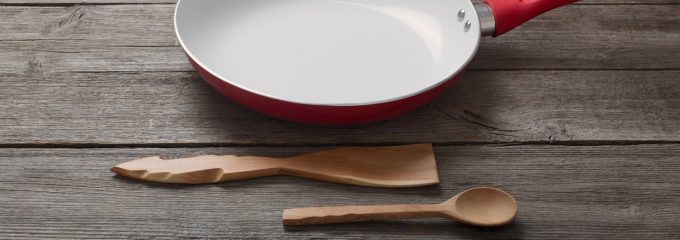Ceramic, copper or non-stick: which pans should I get?

With terms like “carcinogens” and “PFOA” flying around every time someone brings up non-stick cookware, a simple task like buying a new set of pots and pans can become a daunting, even frightening, task. But it doesn’t have to be. If you’re properly informed about each type of material and you know what your needs are in the kitchen, the set of pans should pick itself. Here’s a crash course in the three major types of pans: non-stick, ceramic, and copper.
Non-stick.
You probably grew up using non-stick pans at home. When Teflon and other non-stick surfaces first came out, they were lauded as miracle materials that made cooking and cleanup a breeze. But, eventually, it was discovered that there was a catch. At high temperatures, these non-stick pans released toxic gases, including carcinogenic substances such as perfluorooctanoic acid (PFOA). So although nonstick pans may be more convenient, you’re taking a risk when you use them.
If you do decide to take the non-stick route, there are a few safety guidelines you should follow closely. Most importantly, do not overheat these pans. They should only be used up to 450 degrees; if they near 700 degrees, that’s when the toxic chemicals can be released. Opt for plastic utensils to avoid scraping or abrading the non-stick material and releasing it into your food. And always make sure you have proper ventilation in the kitchen.
Ceramic.
In terms of safety, ceramic and enameled cookware tend to be at the top of the pack. The only potential source of concern is the substance used to treat the ceramic, which was historically lead or cadmium. However, these types of toxic glazes have either been phased out in the United States or reduced to a safe level. So if your ceramic pan is considered food safe, you can assume the proper precautions have been taken.
And when it comes to cooking, there are many perks to using ceramic cookware. It conducts heat evenly to help perfectly brown and sear food, and you can even stick it in the oven if the baking temp is less than 500 degrees. It’s also pretty resistant to wear and tear, so ceramic is a good option if you’ll be using your cookware often.
Copper.
Copper pans give off a retro vibe with the added bonus of being exceptionally good at conducting heat evenly and quickly. But there’s a but. Unlined copper pans can actually leach the element into your food. Although the body does need some copper, the FDA still cautions against using unlined copper pans as your source of the nutrient. Most copper pans come lined, anyway, with a metal that won’t budge like nickel, tin, or stainless steel. Although these materials are pretty durable, they can scrape off if you use steel wool or other abrasive cleaning tool, so stick to a soft sponge.
Something else to keep in mind is that copper pans tend to be on the pricey side, so going this route is going to be something of an investment. They also tend to dent relatively easily, and you can’t use them with an induction stovetop.
Kitchen Cookware [Consumer Reports]
What’s the Safest Cookware? [Mother Nature Network]
Copper Cookware vs. Nonstick Cookware [SF Gate]